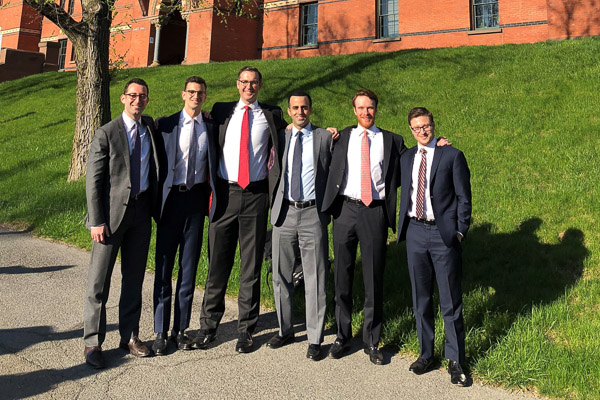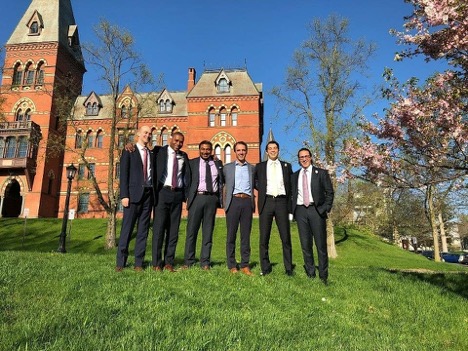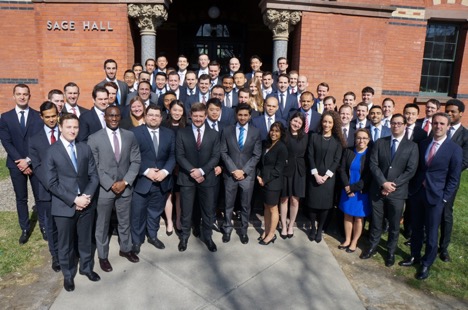Impressions following the investment banking immersion

By Adam Nofal, Two Year MBA ’19
Over the past few months, I’ve become even more convinced that the best way to learn is by doing. Throughout our investment banking immersion (IBI), my teammates and I constantly found ourselves working for hours on end dissecting, understanding, and presenting corporate transactions. Often armed with a Collegetown Bagels beverage in one hand and a marker in the other, we rolled up our sleeves and worked over long stretches of time sketching out all sorts of scenarios our pitch could play out. Grasping not only the financials but also the strategic rationale behind these transactions was of the utmost importance, especially since we knew that Drew Pascarella, senior lecturer of finance, is an expert at poking holes in seemingly cohesive pitches. We had to make our narrative airtight and presentations crystal clear, all in order to outline the value our transactions bring to clients.
Why the IBI?
The IBI is one of the main draws that made me apply to Johnson. While researching various schools, I quickly realized that Johnson’s IBI offers a significant amount of hard skills that are valuable to future employers and immediately applicable to the real world. Moreover, the IBI emphasizes what I think is one of the most central aspects of a workplace: teamwork. With an already hectic schedule as MBA students, IBI teams learn how to draw on experiences of their members by drawing on each person’s expertise in areas such as marketing, operations, strategy, and finance. This collaboration and over-arching sense of camaraderie, in addition to the real-world nature of transactions pitched, all give the IBI a flavor that arguably makes it one of the most realistic programs mimicking a practical experience in the after business school world.
Week in and week out, my classmates and I practiced advising corporate clients on raising capital through debt and equity offerings, initial public offerings, and strategic transactions such as mergers and acquisitions and leveraged buyouts. As the semester progressed, we also advised on transactions including restructuring and capital structure reorganizations, as well as potential spin-offs. But one may wonder, how can some students work on such projects if they don’t have the experience to valuably contribute?
Getting up to speed

I must confess that early on I was skeptical of how a person like me—with minimal knowledge in certain forms of corporate transactions—can develop a strong domain knowledge in these areas. However, as time progressed, a certain pattern began to emerge: After we got the usual Monday email from Drew outlining the upcoming pitch, our team would immediately book a breakout room that would soon turn into a war room. Here we spent countless hours debating our pitch, sifting through industry research, delving into company analyst reports, and modeling various financial outcomes. After a few days of polishing our deck and narrative, we’d finally realize that we’re ready. Our teamwork has made us comfortable analyzing, fully grasping, and presenting the transaction in front of the whole class, from top-level strategy driving the deal, all the way down to the most minimal nuances.
Mergers & acquisitions case
To provide an example, consider our Pitch Me A Deal assignment. Our team combed through dozens of corporate transactions that we believed should happen or are on the cusp of occurring, and picked one to thoroughly analyze and pitch. Though we seriously considered advising GE to spin-off its transportation business, we decided not to go in that direction due to a lack of sufficient public data. Instead, we assumed the role of a buy-side advisor to Alaskan Air Group (Alaskan), recommending that it acquire Hawaiian Holdings (Hawaiian).
At first, Alaskan-Hawaiian may seem like logical match; however, through various concepts we learned throughout the semester, it became clear that we were operating under several constraints. For instance, we became aware that Alaskan is unlikely to take on a significant amount of debt to acquire a larger competitor as it’s already somewhat levered. If Alaskan were to make an acquisition under current circumstances, they’re likely to target a smaller player like Hawaiian. Alaskan also had to consider anti-trust issues, fleet age differences, cost per available seat mile, and revenue per available seat mile, all of which shrunk the pool of potential targets. The knowledge we acquired during the IBI helped us formulate an opinion on those metrics, and it also made us weave in the effect of synergies this transaction would create—from cost cutting due to having similar fleet types to combining various West Coast gates—and know how to represent the impact of those aspects financially.
Read another perspective from the mergers & acquisitions case assignment.
Restructuring case
Another feature of the immersion unique to Johnson is that it gives students the opportunity to work on a restructuring case supervised by Rob Symington, senior advisor at Avenue Capital Group. In this case, Rob brought in his real-world experience examining capital structures of numerous companies as a distressed debt investor and provided guidance and feedback on how to approach capital reorganizations. This time around we explored options available to reorganize the capital structure of Neiman Marcus. The company was under operational stress as a result of inventory management issues, which were only magnified because of fears of its upcoming debt maturity wall. As representors of equity holders, our team deliberated the optimal path to clean up Neiman Marcus’s balance sheet and attempt to set the company back on healthy financial footing. After mapping out our narrative, we concluded that Neiman would be best served negotiating with its creditors without filing for a Chapter 11 Bankruptcy.

Our analyses led us to believe that a successful negotiation with creditors outside of court would potentially materialize if Neiman Marcus sold a percentage of its unencumbered assets to pay down a portion of its bank debt and high-yield bonds, and entered a debt-to-equity swap with high-yield bond holders. The crux of our argument relied on the assumption that, if we pushed the debt maturity wall further into the future through a debt refinancing, Neiman Marcus could survive and even slightly grow in the near future. We reasoned that the economic condition of luxury specialty retailers—a retail category that Neiman Marcus falls under—hasn’t been as underperforming as the rest of the retail industry. Therefore, investors didn’t have to be as concerned about that aspect. As advisors to equity holders, our team’s objective was to illustrate that the company would make bank and bond holders whole, and would have at least some equity value outstanding after the reorganization.
Read another perspective from the restructuring case assignment.
The value of practical experience
As the semester came to a close, I found it hard to imagine how underprepared I would have been for my internship had I not taken the IBI. This immersion was by far one of the most realistic and valuable experiences I’ve ever had within an academic setting. If you’re interested in advising corporations and other entities on strategic transactions and capital raising, I strongly recommend the IBI at Johnson.

About Adam Nofal, Two Year MBA ’19

Adam interned at Citi’s Industrials Group during the summer of 2018. Prior to Johnson, he was a senior associate at EnTrustPermal, a $20 billion asset manager that provides direct private debt financing to the maritime and aviation shipping industries, and invests in private equity secondaries. Adam holds a bachelor’s degree in economics from St. Lawrence University. At Johnson, he serves as an advisor to Blackstone LaunchPad, co-president of the Politics & Geopolitics Club, alumni relations chair for ALPHA, and is a cohort leader.

Comments